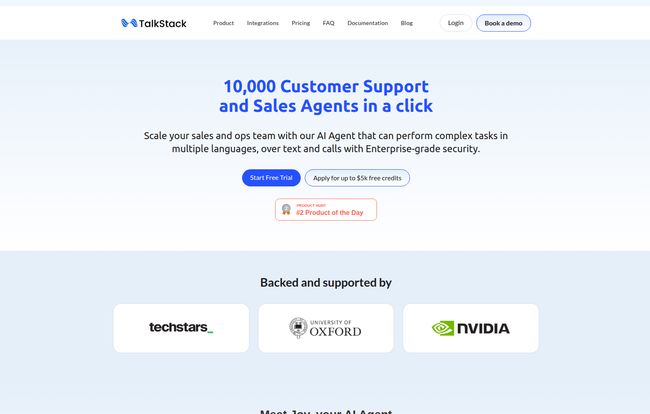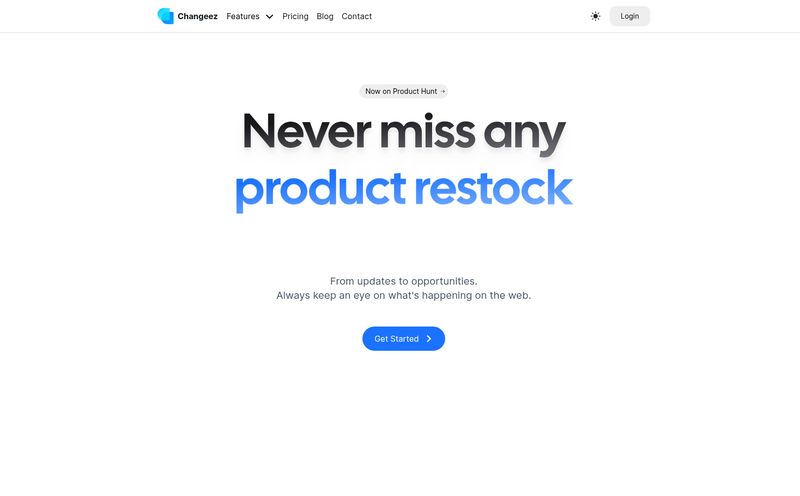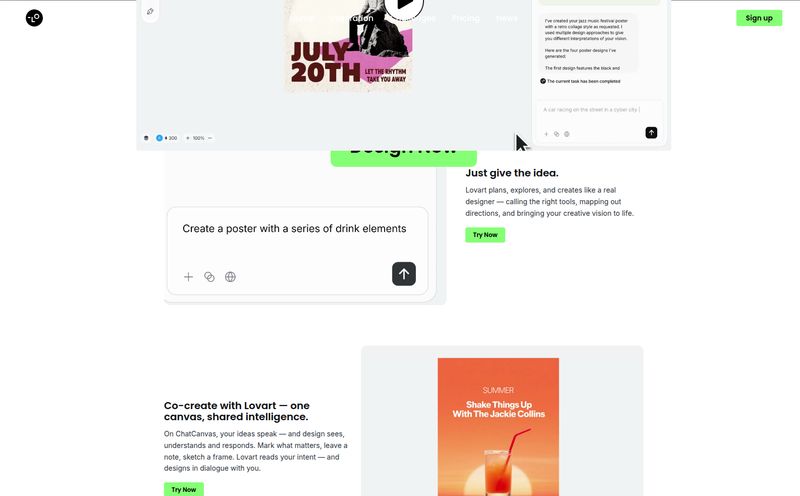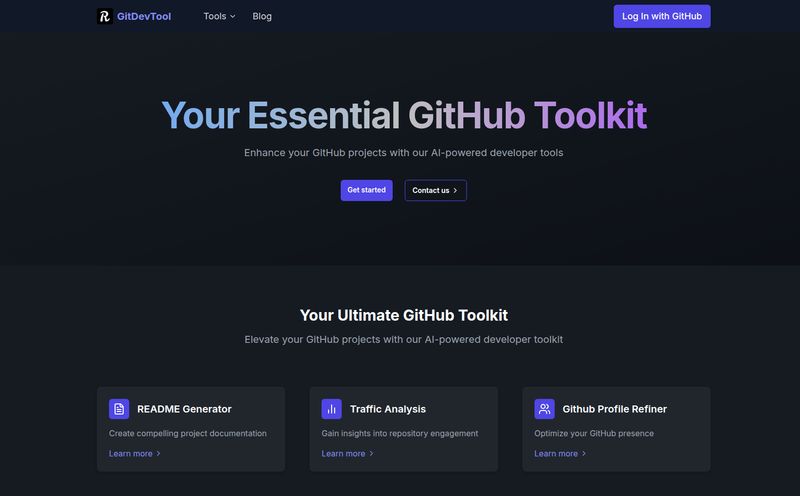We've all been there. Trapped in the automated phone menu from hell. You know the one. "Press 1 for sales. Press 2 for..." and you just keep mashing the zero key, praying to the telecom gods for a real, live human being. The hold music is always some terrible, tinny version of a Vivaldi piece, and by the time you reach someone, you've forgotten why you even called.
It’s the kind of experience that makes you want to throw your phone against a wall. For years, this was the peak of "automation" in customer service. Clunky, frustrating, and deeply, deeply inhuman.
But the ground is shifting. Fast. In the current AI gold rush, a new breed of tools is emerging, promising not just to automate, but to do it with a dash of humanity. One of the names creating a buzz is TalkStack AI. They’re making some pretty bold claims, like offering "10,000 Customer Support and Sales Agents in a click." As someone who’s seen a lot of tech fads come and go, my skepticism meter is always on. But with backing from heavy-hitters like Techstars and NVIDIA, I had to take a closer look.
What Exactly is TalkStack AI? (And Why Should You Care?)
So what's under the hood? At its core, TalkStack AI is a platform that gives you an army of AI-powered voice and text assistants. Think of it less like that old, annoying IVR system and more like a team of super-efficient digital employees. These aren't just simple chatbots that can only answer from a script. The website mentions they're powered by LLMs (Large Language Models), which is the same kind of tech behind things like ChatGPT. This means they can understand context, handle more complex queries, and sound... well, a lot more natural.

Visit TalkStack AI
For a business owner or a marketing manager, the implications are pretty huge. It’s about scaling your operations without scaling your headcount at the same crazy rate. Imagine handling thousands of customer inquiries, qualifying sales leads, or sending out appointment reminders simultaneously, 24/7, in multiple languages. That’s the dream they're selling. But does the reality match the hype?
The Features That Actually Matter
A features list is just a list until you see how it applies to your actual business pain points. I've waded through enough marketing fluff to know what to look for, and a few things about TalkStack AI definatly stood out.
Going Omnichannel is Not a Suggestion Anymore
Your customers are everywhere—they text, they call, they use WhatsApp, they slide into your DMs. If your support is stuck in one channel, you’re failing them. TalkStack AI gets this. Their focus on an omnichannel experience means the conversation can flow from a text message to a phone call without losing context. This is how communication should work in 2024. It’s not revolutionary, but it’s table stakes, and it looks like they do it well.
Speaking Your Customer's Language, Literally
One of the biggest hurdles to going global is language. Hiring a multilingual support team is expensive and complex. This is where AI really shines. The ability to deploy an agent that can speak Spanish, French, or German as fluently as English is a massive advantage. It opens up markets you might have considered out of reach.
An AI That Sounds Like You
I’ve always felt that one of the biggest turn-offs of automation is the generic, robotic feel. Your brand has a voice, a personality. A cookie-cutter bot can kill that vibe instantly. TalkStack AI allows you to create a custom AI agent, tuning its voice and responses to match your brand. It's a small detail, but a critical one for maintaining customer trust and brand consistency.
For the Data Nerds Like Me
Here's the kicker: You can't improve what you can't measure. The platform’s promise of visualized insights is music to my ears. Seeing call durations, resolution rates, and customer sentiment at a glance is how you turn a cost center into a strategic asset. You can spot trends, identify problems, and actually see the ROI of your automation efforts. Without data, you’re just guessing.
Can It Really Automate 98% of Your Work?
Okay, let's talk about the giant number on their website: up to 98% automation. That's an incredible claim. Is it possible? In some specific scenarios, I believe it is. For things like:
- Appointment scheduling and confirmations
- Basic lead qualification (asking the first 5-10 standard questions)
- Answering common FAQs about business hours or locations
- Order status updates
For these repetitive, high-volume tasks, an AI agent is a perfect fit. It's like having a digital Swiss Army knife for your operations team. It frees up your human agents—your actual experts—to handle the complex, emotional, and high-value conversations that truly require a human touch. And that’s the key. This tool isn’t about firing your support team. It's about making them more powerful.
Some might argue that you lose the human connection. And they're not wrong, if implemented poorly. The smart play is to have a seamless escalation path. When the AI gets stuck or the customer says the magic words—"I want to speak to a human"—the transfer needs to be smooth. TalkStack seems to support this, which is crucial for not alienating your user base.
Let's Talk About the Money: A Breakdown of TalkStack AI Pricing
Alright, let's get down to brass tacks. Every business owner wants to know: what's this going to cost me? The pricing model is usage-based, which I personally like because it scales with you. Here’s a quick breakdown I’ve put together based on their site.
| Plan | Cost Per Minute | Best For | Key Perks |
|---|---|---|---|
| Trial | $0.15 | Teams just getting started or with low call volume. | Pay-as-you-go, no setup fees. |
| Starter | $0.12 | Teams with over 5,000 call minutes/month. | White glove onboarding, 1000 free minutes, custom integrations. |
| Enterprise | As low as $0.05 | Large teams with over 10,000 call minutes/month. | Volume discounts, dedicated manager, on-prem option. |
My take? The pricing is transparent and fair. The per-minute model means you only pay for what you use, but you need to monitor it. A poorly configured agent that keeps people on the line for too long could get expensive. The real value seems to kick in at the Starter level, where the per-minute cost drops and you get that white-glove onboarding. For any serious implementation, that hands-on help is worth its weight in gold.
The Enterprise plan is clearly for the big leagues, and the on-premise option will be a major selling point for industries with strict data compliance rules like finance or healthcare.
My Personal Verdict and Final Thoughts
So, is TalkStack AI the magic bullet for all your sales and operations woes? No, of course not. No tool is. There’s an initial setup period where you have to invest time to get your agent dialed in. And you absolutely must have a strategy for human oversight for those tricky, nuanced conversations.
But here's what I think. The potential here is enormous. The ability to scale your customer-facing operations without a linear increase in cost is a game-changer. The multilingual support alone is a huge competitive advantage. In my experience, the businesses that will win are the ones that learn to blend automation and human expertise effectively.
This tool is perfect for a fast-growing startup that can't hire support staff quickly enough, an e-commerce brand that gets slammed during the holidays, or any company looking to automate the repetitive tasks that burn out their best people. If your business is built exclusively on high-touch, white-glove service for a handful of clients, this might be overkill. But for everyone else? It's worth a serious look.
Frequently Asked Questions about TalkStack AI
Is TalkStack AI difficult to set up?
It's not a single click, but it's designed to be user-friendly. Based on their site, you can create a custom agent in a few steps. For more complex workflows, especially with the Starter and Enterprise plans, they offer onboarding and support to get you integrated with your existing systems.
How “human” does the AI actually sound?
Since it's built on modern LLMs and text-to-speech models, it's a world away from the robotic voices of the past. The goal is a natural, conversational flow. You can even call their demo number on the website to hear "Joy," their AI agent, in action.
Can it integrate with my existing CRM?
Yes. The Starter and Enterprise plans explicitly mention "custom system integrations." This is key for a seamless workflow, allowing the AI to pull customer data from your CRM (like Salesforce or HubSpot) and push new information back, like call notes or newly scheduled appointments.
Is my customer data secure with TalkStack AI?
They advertise "enterprise-grade security." For businesses on the Enterprise plan, they even offer an on-premise option, which means the software can run on your own servers. This is a critical feature for companies with stringent data privacy and compliance requirements.
What happens if the AI can't answer a customer's question?
A good AI system knows its limits. The platform is designed to support human escalation. This means when a conversation gets too complex or a customer requests a person, the call can be seamlessly transferred to a live agent, often with the context of the conversation so far.
The Final Word
Look, the future of customer interaction isn’t about replacing all humans with robots. It’s about creating a smarter system where technology handles the grunt work, and people handle the moments that matter. Tools like TalkStack AI are at the forefront of this shift. It's an exciting, and frankly, necessary evolution. If you're drowning in repetitive calls and emails, it might just be the life raft you’ve been looking for.
Reference and Sources
- TalkStack AI Official Website
- TalkStack AI Pricing Page
- Gartner on the Future of AI in Customer Service
- NVIDIA's Role in AI and Data Science



